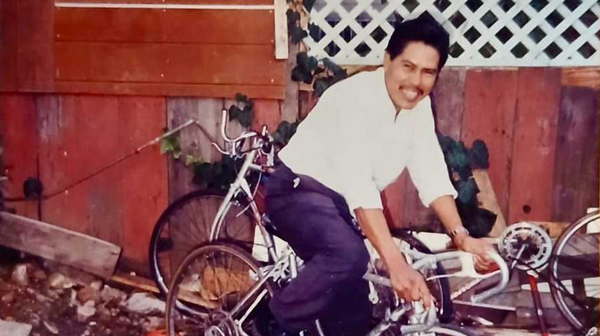The Covid pandemic brought into sharp focus the need to reassess life’s priorities. With this in mind, organisers of the Biennale Internationale Design Saint-Étienne, in eastern France, went with “bifurcation" – the French word for “fork in the road” – as this year's theme, telling visitors to "choose what matters".
With Africa as the guest of honour, visitors will have four months in Saint-Étienne, a Unesco "creative city of design", to discover innovative objects, services and installations presented in seven major exhibitions.
Some 235 artists and designers are represented across 100 exhibitions and 48 installations with a focus on African innovation.
Beyond that are workshops, conferences, concerts and a host of other exhibits in various locations.
Multiple paths
Life, as it turns out, is full of “bifurcations”, constantly influenced by events that force us switch change direction, for better or for worse. Left or right? Up or down? Fast or slow? Coal or nuclear? New or recycled?
The global Covid pandemic was surely one of those moments.
“With this biennial, we discover how the designers write their roadmap with others, multiply the paths they take, share their tools, ponder the forms of poverty, sobriety, frugality," says the event's scientific director, Olivier Peyricot.
"We see how that echoes through our immediate material environment."

Africas, plural
The exhibition “Singulier Plurielles: In the contemporary Africas”, curated by architectural researcher and scenographer Franck Houndégla, seeks to share design practices used in urban and rural communities in contemporary Africa, and determine how they could be applied elsewhere.
On display are low-tech handwash stations that came out of an ESADSE workshop (Saint-Étienne Higher School of Art and Design) following on from a Senegalese project, designed by Bassirou Wade.
There is also an eHealth scheme that facilitates medical care, an integrated agro-ecological production centre and contemporary furniture designed with a network of craftspeople and locally sourced materials.
Among the artists involved is Chaz Maviyane-Davies from Zimbabwe, an artist who returns to themes of human rights and social justice.

Visitors will be able to admire an installation of "microarchitecture", an original creation by Cheick Diallo, as part of the “Parcours des Bifurcations” – an outdoor immersive pathway allowing pedestrians to connect the various exhibition halls while viewing sculptures.
Meanwhile “Autofiction – A Biography of the Car-Object” is an exploration of desire versus need, focusing on people’s obsession with cars.
While the number of cars on earth passed the 1.2 billion mark in 2020, there has been a move towards rethinking the way we consume, rethinking our relationship with our resources, and rethinking our political and social standpoints.

One of the workshops connected to this exhibition questions the advent of the electric car and its impact in the Democratic Republic of the Congo. It's based on a project by artist Jean Katambayi, in Lubumbashi.
“The Water Jet garden”(5 April – 31 July) is a build-a-garden in real time project at La Serre, a former beaux-arts school, where Emmanuel Louisgrand will recreate a waterjet garden she made in the Sicap neighbourhood of Dakar, Senegal.
It was the artist’s way of resisting the encroachment of urban areas on nature. In this installation she revisits the formal French garden in a contemporary African version and invites other designers at the Biennale to present their works here.
“Portraits Caméléon” (1 June – 31 July) is a surprising display of photos at Parc Labesse by Myette Fauchère who explores the notion of a collective identity in African society, in particular through the theme of ceremonies and rituals.
She creates an optical illusion for the viewer by getting the people in her photos wear clothes of a matching colourful fabric, against a background of the same fabric. In the end, all that is visible are the black faces, hands and feet.
Africa is also a central focus at the MAMC+ Modern and Contemporary Art Museum, where the public will be introduced to the humanist principles of "Botho", a world view based on the southern African culture of respect.
The “Globalisto: a Philosophy in Motion” is a collective exhibition (25 June – 16 October) brings together 15 artists of different generations, nationalities and backgrounds, such as Gerard Sekoto and Josèfa Ntjam.
Home away from home
Other main exhibits include “Unfolding (Dépliages): The Body and the Industrial Object Get to Grips”, curated by Florian Traullé.
It's an opportunity to see how designers are adapting to changing needs and constraints, be they technical, ecological, social or economic.
How about a collector for rainwater so that it is there when you really need it?

Or a haute couture outfit made from ready-to-wear offcuts?

“At Home: A Panorama of Our Domestic Lives” looks at every aspect of the modern home, which has become so much more than a simple shelter: it's an office, a playground, a staging area for social media.
Curators Penny Sparke, Jana Scholze, Catharine Rossi from Kingston University in London have chosen five main themes to explore the home from a historical perspective, its association with constructing an identity, the need for sustainability, and the “connected” home, with the latest gadgets.

The The Biennale Internationale Design Saint-Étienne runs from 6 April to 31 July, 2022.







